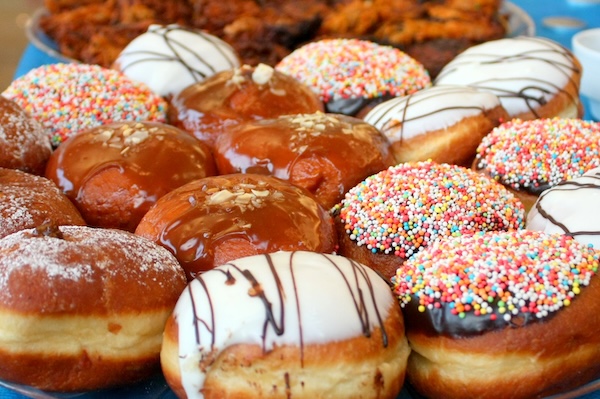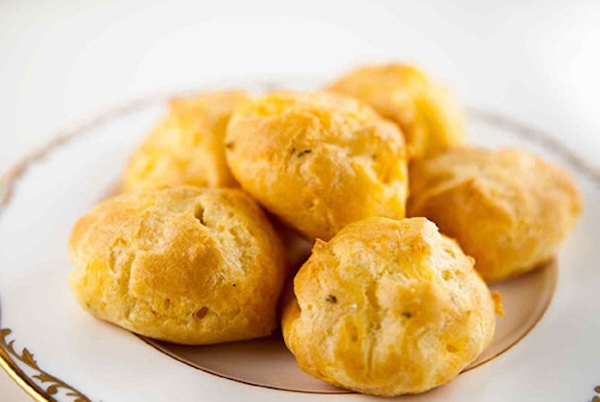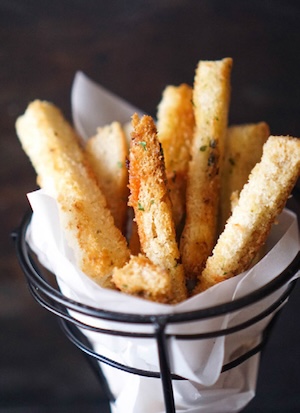Sufganiyot (jelly doughnuts) for Hanukkah have come a long way, and now come in countless variations. (photo by Avital Pinnick / Flickr)
In Israel, sufganiyot (jelly doughnuts) have gone through a major revolution. For years, they were injected with strawberry jelly and dusted with confectioners’ sugar. In a recent ad by a well-known Israeli bakery, there were 14 variations of sufganiyot, including the “classic strawberry jam.” Twelve are dairy and two are pareve (can be eaten with milk or meat dishes).
For the pareve offerings, there are colourful sprinkles, dairy-free chocolate and ganache (filling made from chopped chocolate and heavy cream). Among the dairy choices are “Raspberry Pavlova,” filled with sweet cream and topped with raspberry ganache, pavlova (a meringue named after the Russian ballerina, Anna Pavlova), sweet cream and Amarena cherries; “Curly,” filled with cream and topped with Belgian chocolate and milk, dark and white chocolate curls; “Mozart,” filled with nougat-flavoured sweet cream, frosted with white chocolate strips and topped with Mozart cream (a chocolate liqueur) and chocolate curls; “Cheese Crumbs,” filled with cheese mixed with white chocolate and butter cookie crumb frosting and topped with cream cheese; and “Pistachio,” filled with pistachios, frosted with white chocolate ganache, and topped with pistachio cream and pistachio shavings.
Jewish law does not prescribe any special feasting or elaborate meal for Hanukkah as it does for other holidays. Maybe this is because the origin of Hanukkah is not in the Torah but in the Apocrypha, the books of literature written between the second century BCE and the second century CE, which were not incorporated into the Hebrew Bible.
The Books of Maccabees, of which there are four separate books, only say that the hero, Judah, “ordained that the days of dedication of the altar should be kept in their season from year to year by the space of eight days from the first and 20th day of the month Kislev, with mirth and gladness.”
So, where do we get all the food we eat? It is in the Talmud, where the so-called miracle of the oil burning for eight days is written. This myth was inserted to de-emphasize the miracle of military triumph and replace it with a more palatable idea, that of the intervention of G-d, which somehow would seem more a miracle than a fight of man against man, according to the sages of the time. (By the way, it is only within the past few years that children’s books about Hanukkah dare say the oil story is a legend or a myth.)
Practically every Jewish ethnic group has the custom of making and eating a form of food prepared in oil as a reminder of the “miracle” of the jar of oil.
The late Gil Marks wrote, in The World of Jewish Desserts, that doughnuts fried in oil, ponchikot, were adopted by Polish Jews for Hanukkah. The name is taken from the Polish word paczki, which led to the nickname ponchiks, the Polish name for jelly doughnuts. Ponchiks are similar to jelly doughnuts, only larger and more rich tasting, and were traditionally served on Shrove Tuesday, the day before Lent. They were made to use up shortening and eggs, which were prohibited during Lent.
Sufganiyot have a different history. In The Jewish Holiday Kitchen, Joan Nathan, an acquaintance of mine from our Jerusalem days and noted cookbook author and maven of American Jewish cooking, noted that she learned the origins of sufganiyot from Dov Noy (z”l), former dean of Israel folklorists.
Noy related a Bukhharian fable to Nathan, which says that the first sufganiya was a sweet given to Adam and Eve as compensation after their expulsion from the Garden of Eden. Noy said the word sufganiya came from the Hebrew word sof, meaning end; gan, meaning garden; and Ya, meaning G-d. Thus, the word means, “the end of G-d’s garden.”
According to Noy, this fable was created at the beginning of the 20th century, as sufganiya is a new Hebrew word coined by pioneers. Some say sufganiyot means sponge-like and that the doughnuts are reminiscent of the sweet, spongy cookie popular along the Mediterranean since the time of the Maccabees. Hebrew dictionaries say the word actually comes from the Greek word sufgan, meaning puffed and fried.
John Cooper, author of Eat and Be Satisfied: A Social History of Jewish Food, has another theory. He says Christians in Europe ate deep-fried pastries on New Year’s Eve, and Christians in Berlin ate jelly doughnuts. In that context, German Jews started eating apricot-filled doughnuts. When they immigrated to Palestine in the 1930s, they encouraged the population to eat the jelly doughnuts for Hanukkah.
One of my favourite pieces of research is the characteristics that sufganiyot are said to have:
• they are round like the wheel of fortune;
• they have to be looked at for what is inside, not for their external qualities; and
• they cannot be enjoyed the same way twice.
My research on the internet shows the calories for one sufganiya vary from 93 to 276, and gluten-free versions with rice flour are about 165 calories.
Whatever their origin – or number of calories – sample the real thing and you won’t forget it!
Sybil Kaplan, z”l, was a Jerusalem-based journalist and author. She edited/compiled nine kosher cookbooks and was a food writer for North American Jewish publications, including the Jewish Independent. We communicated regularly, but mostly in the leadup to a holiday issue. Not having heard from her in advance of this Hanukkah paper, we reached out, getting the sad news that Sybil recently passed away. It was a pleasure working with her for these past 20+ years and we will miss her. She always provided more stories than we could use, so, in this issue, we run a few we had yet to publish, honouring her in our way. May her memory be for a blessing.



